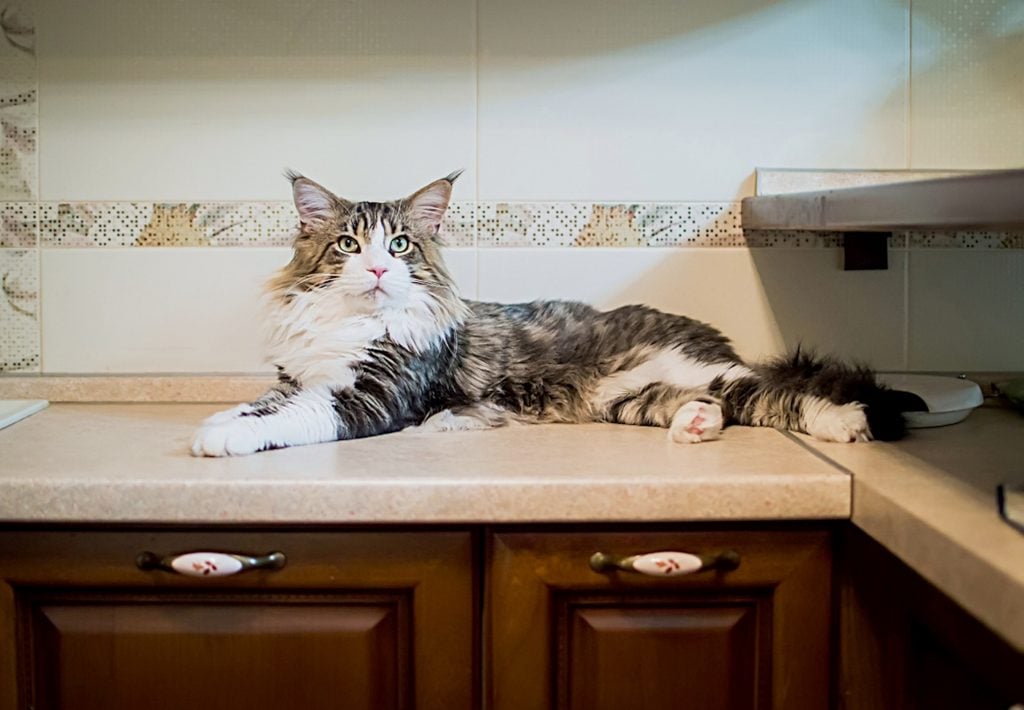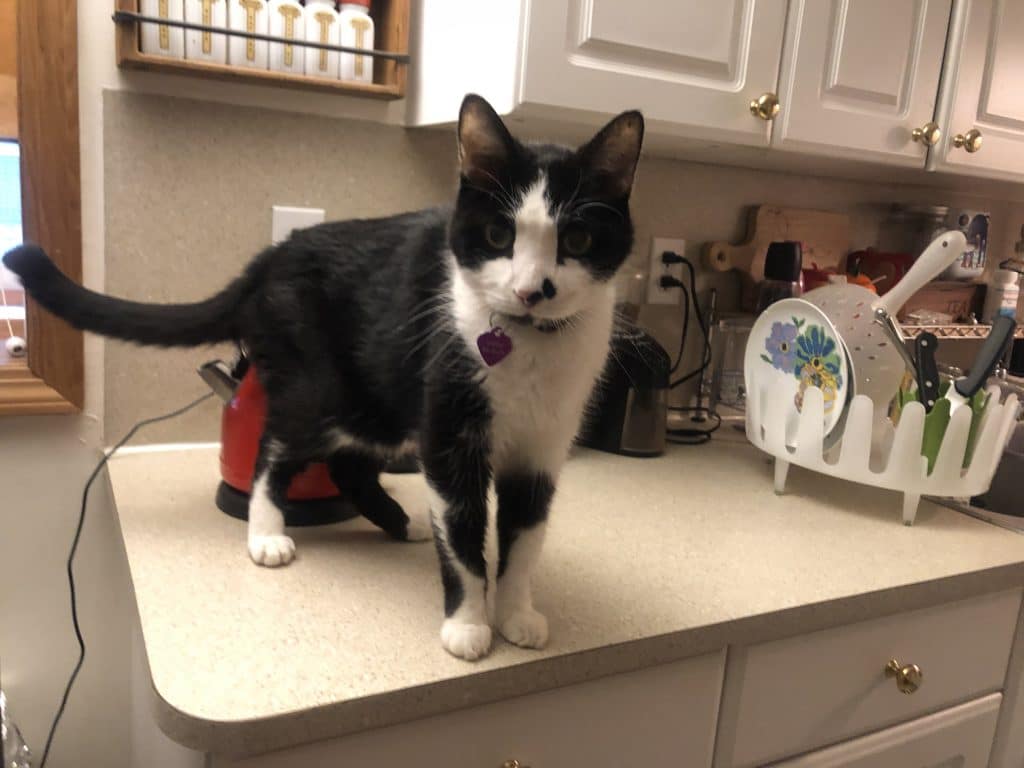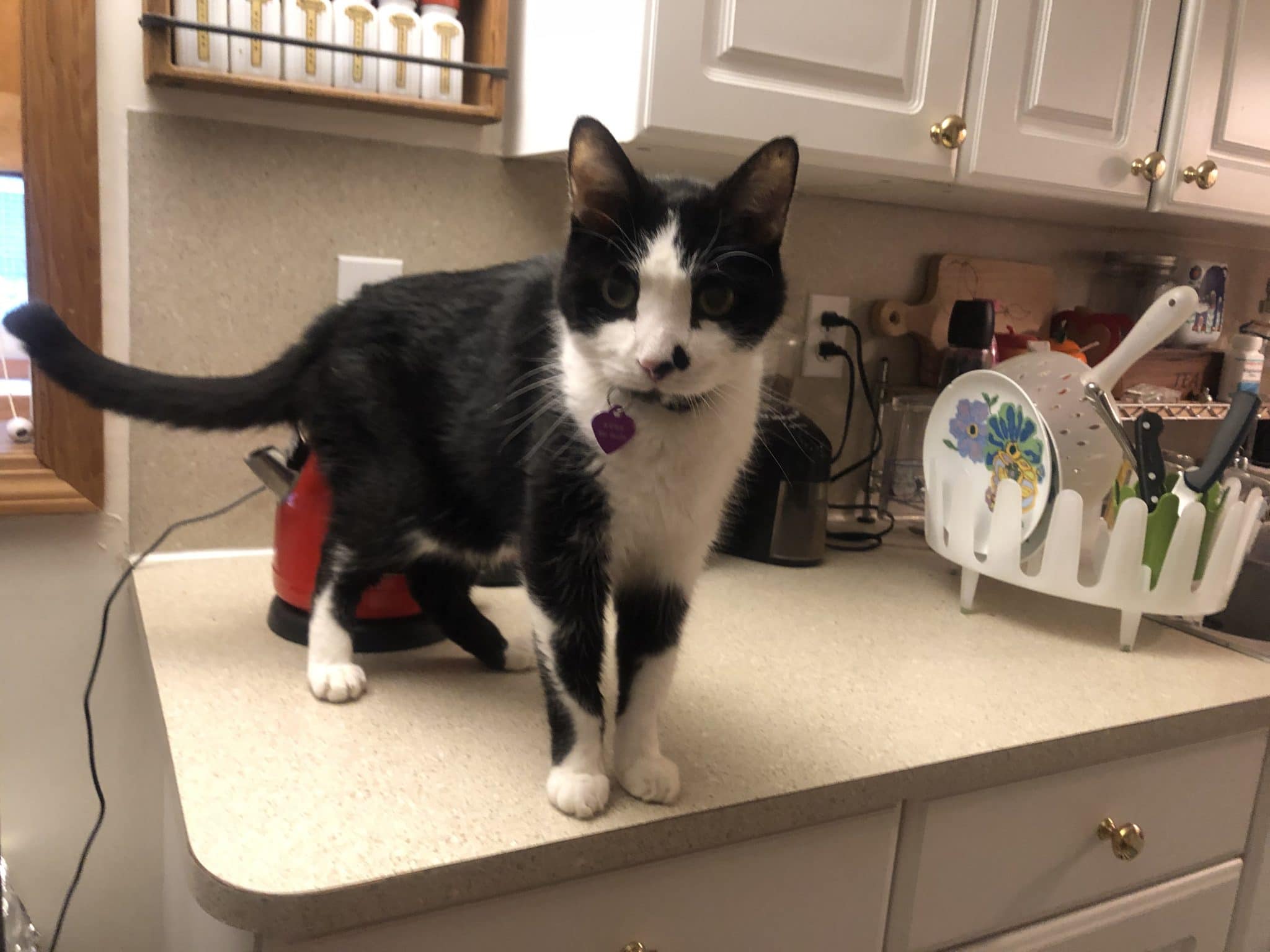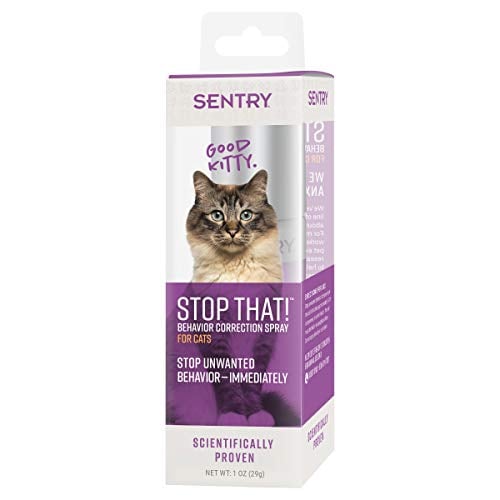- This post contains affiliate links. Read more here.
- Not a substitute for professional veterinary help.
My cat Richie is a countertop hopper extraordinaire. In fact, I’d wager he spends as much time on the counter or kitchen table as he does on the many cat trees and scratching posts in my house. Over the years, I’ve tried all sorts of things to keep my cat off counters and other surfaces. Aluminum foil, air-puffers, new and unusual cat furniture: if an expert recommends it, we’ve tried it.
In this post, we’ll share some of the most popular methods to keep cats off counters. But first, we’ll look at why cats jump on the counter in the first place. Read on to solve the mystery of the counter-hopping cat!
Why Do Cats Jump on the Counter?
Climbing is a natural expression of your cat’s instincts. According to VCA Animal Hospitals, cats may climb to seek higher ground when they feel stressed out: “High vantage points allow your cat to observe the world from a place of safety and escape if it feels the need to do so.” If your cat seems nervous when they hop on the counter, it may be time to explore what might be stressing them out.
On the other hand, some cats jump on the counter simply because they can, and it feels good! Felines are physically built for climbing, with springy back haunches and claws built for pulling them up trees, hillsides, and other surfaces in the wild. In an interview with WebMD, veterinarian Dr. Aimee Simpson explains, “Cats have large muscles in their hind limbs that allow them to extend and lengthen, and a flexible spine with shock-absorbing discs for a graceful landing.” Stretching, reaching, and jumping onto the countertop may be an expression of your kitty’s athleticism.
But all that doesn’t explain why some cats prefer countertops to cat trees and other surfaces. It’s possible your cat jumps on the counter out of plain old curiosity. My cat Richie has always been obsessed with human food, and I often find him on the countertop trying to clean up a dirty dish or nibble a piece of fruit ripening on the windowsill. He’s not trying to be “naughty,” he’s just being his quirky, curious self.

iStock/Natalya Vilman
How Do I Stop My Cat From Jumping on the Desk (or Countertop, or Kitchen Table…)?
One of the first steps to keeping your cat off the counter is to make the counters less appealing to them. Experts at the Anti-Cruelty Society explain, “as responsible pet owners, we want to give our pets the best chance possible to behave well.” That means setting them up for success by removing the temptation to jump up in the first place.
For some cats, that means cleaning up food scraps before your kitty can sniff them out, installing child-proof latches to keep them out of cupboards, and (ugh) doing the dishes in a timely manner. Puzzle feeders and lick mats are helpful tools to redirect your kitty’s food-seeking behavior.
If your cat is more driven by curiosity than hunger, then it’s smart to provide alternative elevated spaces they can explore. Cat trees, window perches, and wall-mounted shelves are all great options. In fact, for the extra-curious cat you might want to provide all three!
Check out these posts for suggestions of cat furniture to keep your climber happy:
1. Top Cat Furniture for Apartment Dwellers
2. 19 Modern Cat Trees to Buy Immediately
3. Your Kitty Will Cuddle Up Into These Cozy Cat Hammocks
Does Aluminum Foil Keep Cats Off Counters?

Author’s cat, Richie, on the kitchen counter
One of the most common “home cures” for counterhopping is putting aluminum foil on the countertops. Common wisdom says that kitties don’t like the sensation of foil under their feet, and will avoid surfaces as a result. In reality, your experience may vary. My cats have mastered the art of knocking foil sheets out of the way, but some people have great success with the foil trick!
Covering the counter with an unpleasant material is sometimes referred to as “booby trapping” your cat. As explained in this article from VCA Animal Hospitals, “booby trapping” can deter cats from unwanted behavior. The idea is to make the surface unpleasant for them to walk on, which will hopefully lead them to explore alternate spots (like that beautiful cat tree you got them). Foil is only one option; I’ve also used plastic carpet runners (with the nubby side up), plastic sheeting, and double-sided tape to keep my kitties off the counter. You can also try setting up stacks of cans or other lightweight items that will make noise when knocked over, although some cats enjoy this kind of obstacle course!
What Scent Will Keep Cats Away?
If altering the surface doesn’t work for your cat, you might wonder if there’s a scent that will keep them off of the counter. There are products that use pheromones to soothe and deter kitties, such as the Sentry Stop That! Spray, the idea being that the pheromone scent will deter cats from a surface.
Cat-safe pheromone sprays don’t hurt, but they do need to be used correctly to teach cats to redirect their curiosity. Think of them as a tool, not a punishment. As the Anti-Cruelty Society explains, “The use of physical punishment will NOT help in training your feline friend, but rather will make her fear you…avoid yelling at, hitting, or spraying your cat with water.” To avoid your cat forming fearful associations with you, you might try a motion-activated air blower. Products like Ssscat shoot a cat-safe blast of unscented air when kitties cross their paths. These can be a useful “booby trap” deterrent, although Richie quickly learned to simply walk around them in his quest to reach the countertop.
My favorite scent-based deterrent is the Feliway pheromone diffuser, which releases a calming scent (pretty much undetectable to humans) that may soothe kitties who climb out of anxiety.
Be Persistent and Provide Alternatives
Cats love to jump and explore. It’s simply in their nature to get up high! In general, the best way to keep your cat off the countertop is to make sure they have access to alternate surfaces. If your kitty prefers the countertop to the cat tree, it may take some time to train them to redirect to another surface. Be patient, and remember that your cat is just being a cat In the meantime, be sure to have a good non-toxic cleaner on hand to wipe up those paw prints!


3 Comments